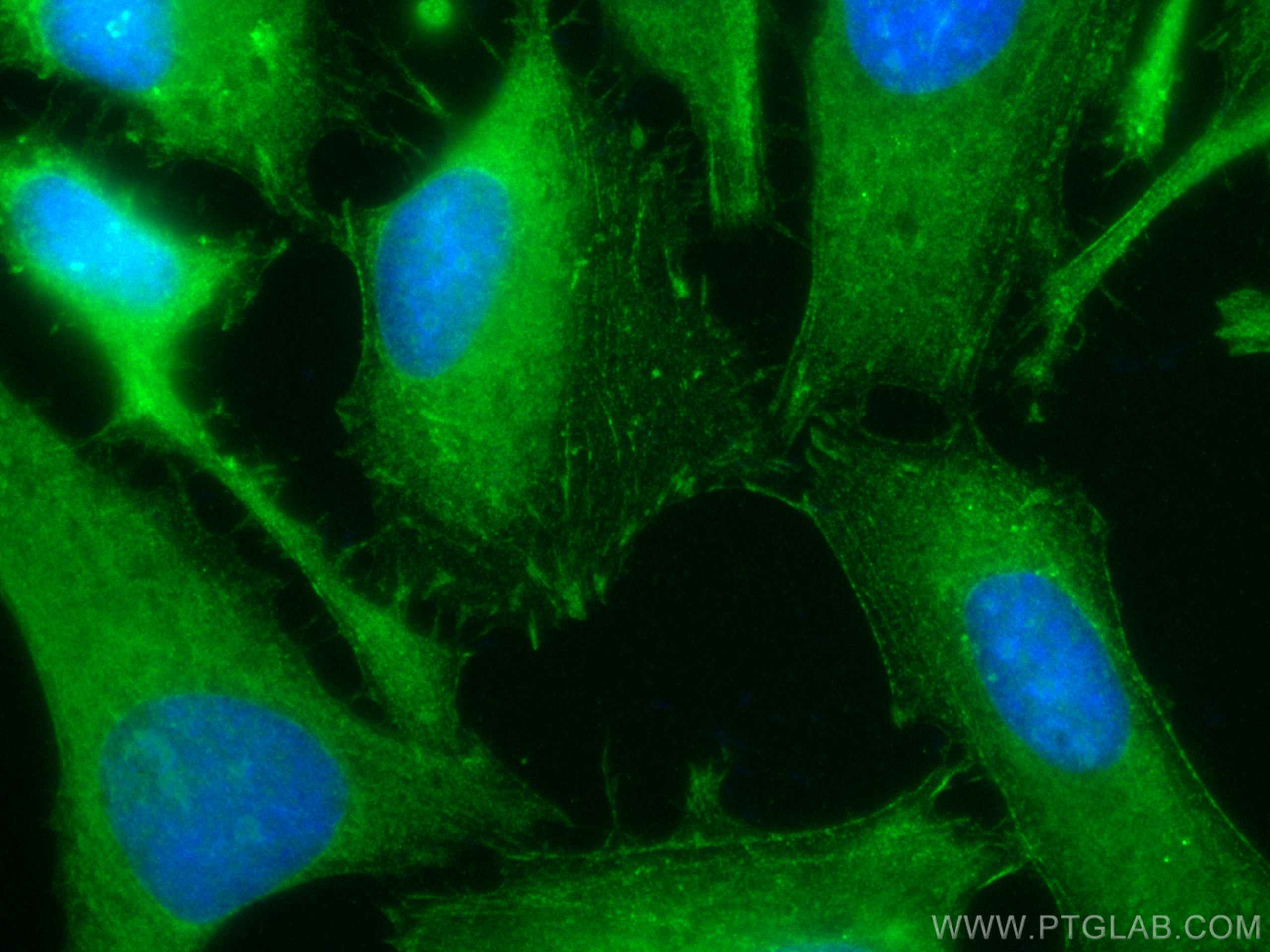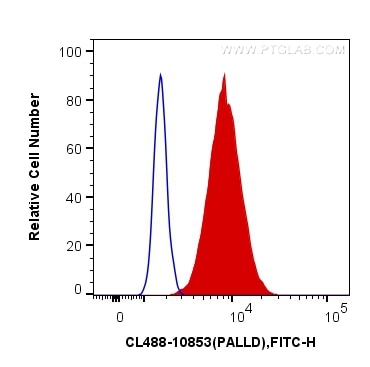- Phare
- Validé par KD/KO
Anticorps Polyclonal de lapin anti-Palladin
Palladin Polyclonal Antibody for IF/ICC, FC (Intra)
Hôte / Isotype
Lapin / IgG
Réactivité testée
Humain
Applications
IF/ICC, FC (Intra)
Conjugaison
CoraLite® Plus 488 Fluorescent Dye
N° de cat : CL488-10853
Synonymes
Galerie de données de validation
Applications testées
| Résultats positifs en IF/ICC | cellules HeLa, |
| Résultats positifs en FC (Intra) | cellules HeLa, |
Dilution recommandée
| Application | Dilution |
|---|---|
| Immunofluorescence (IF)/ICC | IF/ICC : 1:50-1:500 |
| Flow Cytometry (FC) (INTRA) | FC (INTRA) : 0.20 ug per 10^6 cells in a 100 µl suspension |
| It is recommended that this reagent should be titrated in each testing system to obtain optimal results. | |
| Sample-dependent, check data in validation data gallery | |
Applications publiées
| IF | See 1 publications below |
Informations sur le produit
CL488-10853 cible Palladin dans les applications de IF/ICC, FC (Intra) et montre une réactivité avec des échantillons Humain
| Réactivité | Humain |
| Réactivité citée | Humain |
| Hôte / Isotype | Lapin / IgG |
| Clonalité | Polyclonal |
| Type | Anticorps |
| Immunogène | Palladin Protéine recombinante Ag1288 |
| Nom complet | palladin, cytoskeletal associated protein |
| Masse moléculaire calculée | 1383 aa, 151 kDa |
| Poids moléculaire observé | |
| Numéro d’acquisition GenBank | BC013867 |
| Symbole du gène | palladin |
| Identification du gène (NCBI) | 23022 |
| Conjugaison | CoraLite® Plus 488 Fluorescent Dye |
| Excitation/Emission maxima wavelengths | 493 nm / 522 nm |
| Forme | Liquide |
| Méthode de purification | Purification par affinité contre l'antigène |
| Tampon de stockage | PBS with 50% glycerol, 0.05% Proclin300, 0.5% BSA |
| Conditions de stockage | Stocker à -20 °C. Éviter toute exposition à la lumière. Stable pendant un an après l'expédition. L'aliquotage n'est pas nécessaire pour le stockage à -20oC Les 20ul contiennent 0,1% de BSA. |
Informations générales
Palladin is an actin associated protein serving as a cytoskeleton scaffold, and actin cross linker, localizing at stress fibers, focal adhesions, and other actin based structures. Palladin exists as multiple isoforms through alternative transcription initiation sites and splicing. There are three major isoforms (200, 140, 90-92 kDa) and multiple minor isoforms. Different palladin isoforms are expressed in a tissue-specific pattern during development and in adult organs: the 200 kDa isoform is predominantly expressed in the heart, skeletal muscle, testis and bone; the 140 kDa isoform is widely expressed with the exception of liver, muscle, and skin; the 90-92 kDa isoform is broadly expressed in embryonic tissues and highly expressed in adult smooth muscle tissues (21455759). Recently overexpression of palladin has been linked to the promoted invasive motility in several types of cancers (18978809, 22291919). The 85-90 kDa palladin isoform has been observed predominantly expressed in pancreatic ductal adenocarcinoma (PDA) while a 65 kDa isoform is expressed in normal pancreas and non-PDA tumors (20436683). This antibody, generated against the fragment 999-1383aa of palladin, recognizes most isoforms of this protein, except isoform 6.
Protocole
| Product Specific Protocols | |
|---|---|
| IF protocol for CL Plus 488 Palladin antibody CL488-10853 | Download protocol |
| FC protocol for CL Plus 488 Palladin antibody CL488-10853 | Download protocol |
| Standard Protocols | |
|---|---|
| Click here to view our Standard Protocols |



